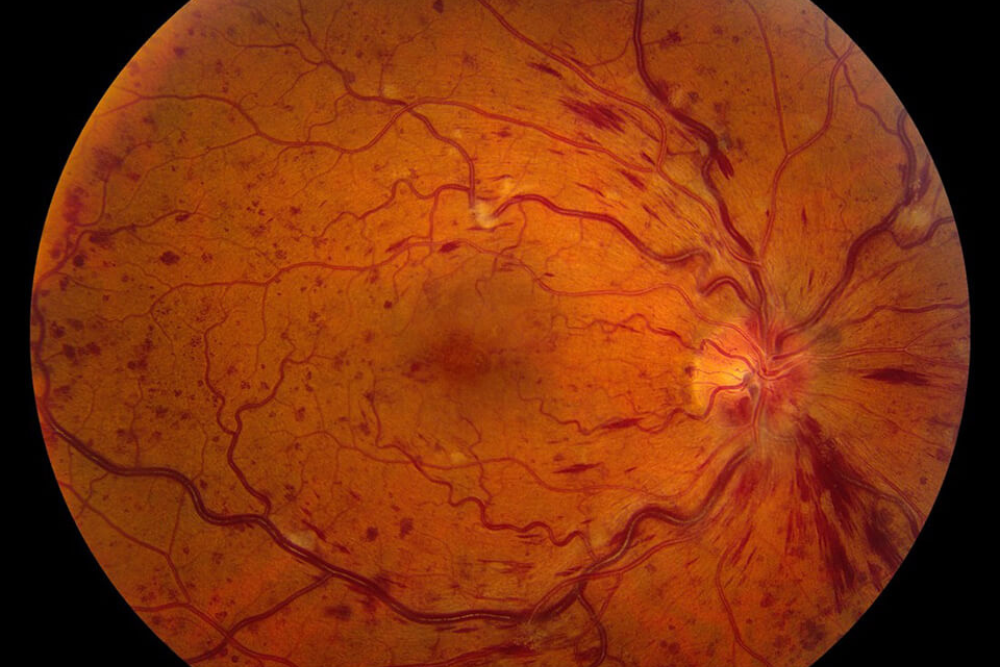Managing Sudden Changes in Vision Linked to Eye Circulation
If you’ve suddenly lost part or all of your vision in one eye without any pain, it could be due to a retinal vascular disorder. These conditions affect the blood vessels that supply the retina and can have a rapid and lasting impact on your sight. The most common include Central Retinal Vein Occlusion (CRVO), Branch Retinal Vein Occlusion (BRVO), Central Retinal Artery Occlusion (CRAO), and Branch Retinal Artery Occlusion (BRAO).
At London Eye & Retina, we provide urgent assessment and treatment for these conditions, aiming to preserve as much vision as possible while identifying underlying causes to reduce future risks.
What Are Retinal Vascular Disorders?
These conditions occur when blood flow to or from the retina is blocked, similar to a stroke in the eye. Depending on the affected vessel, symptoms and severity can vary:
1. CRVO (Central Retinal Vein Occlusion)
Blockage of the main retinal vein leads to widespread swelling and bleeding in the retina.
2. BRVO (Branch Retinal Vein Occlusion)
Blockage of a smaller vein, affecting only part of the retina.
3. CRAO (Central Retinal Artery Occlusion)
A rare emergency where the central artery is blocked, cutting off oxygen supply to the retina.
4. BRAO (Branch Retinal Artery Occlusion)
A partial blockage of a smaller retinal artery.
What Causes These Conditions?
Several systemic health issues can increase your risk, including:
- Hypertension (high blood pressure)
- Diabetes
- High cholesterol
- Glaucoma
- Smoking
- Cardiovascular disease or clotting disorders
In younger patients, clotting abnormalities or inflammatory conditions may also be investigated.
Symptoms to Watch For
Symptoms typically appear suddenly and may include:
- Sudden vision loss in one eye
- Blurred or distorted vision
- A dark spot or shadow in part of the visual field
- In CRAO, vision loss may be near-complete and painless.
These symptoms warrant immediate medical attention, especially in cases involving arterial occlusions, where every minute counts.
How Are They Diagnosed?
At London Eye & Retina, we use advanced diagnostic tools to confirm the type and extent of the vascular event:
- Dilated retinal examination
- Optical Coherence Tomography (OCT): To assess swelling or structuraXl changes
- Fluorescein Angiography: To map blocked or leaking vessels
- Visual field testing and imaging for underlying systemic risks
We often coordinate with your GP or cardiologist to manage risk factors comprehensively.
Treatment Options
Treatment varies depending on the specific condition:
CRVO & BRVO
- Anti-VEGF injections to reduce macular oedema and restore vision
- Steroid injections or implants in selected cases
- Laser therapy in certain BRVO cases to prevent further complications
CRAO & BRAO
- Immediate attempts to restore blood flow may include ocular massage, reducing intraocular pressure, or inhalation therapy.
- Long-term management involves cardiovascular evaluation and preventing further events.
- Vision recovery is often limited, especially if treatment is delayed.
Why Timely Care Matters
Retinal vascular disorders not only threaten your vision but can be a sign of broader vascular issues affecting your heart or brain. Prompt diagnosis and treatment improve your chance of visual recovery and help reduce the risk of future vascular events.
Schedule a consultation with Dr. James Ng at London Eye & Retina and explore your options for clearer, sharper sight.
Let us help you protect your vision and overall vascular health.


